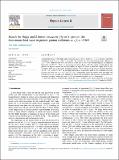| dc.contributor.author | CMS Collaboration | |
| dc.contributor.author | Abercrombie, Daniel Robert | |
| dc.contributor.author | Allen, B. | |
| dc.contributor.author | Azzolini, Virginia | |
| dc.contributor.author | Barbieri, Richard Alexander | |
| dc.contributor.author | Baty, Austin Alan | |
| dc.contributor.author | Bauer, Gerry P | |
| dc.contributor.author | Bi, R. | |
| dc.contributor.author | Brandt, S. | |
| dc.contributor.author | Busza, Wit | |
| dc.contributor.author | Cali, Ivan Amos | |
| dc.contributor.author | D'Alfonso, Mariarosaria | |
| dc.contributor.author | Demiragli, Zeynep | |
| dc.contributor.author | Gomez-Ceballos, Guillelmo | |
| dc.contributor.author | Goncharov, Maxim | |
| dc.contributor.author | Harris, Philip Coleman | |
| dc.contributor.author | Hsu, D. | |
| dc.contributor.author | Hu, M. | |
| dc.contributor.author | Iiyama, Yutaro | |
| dc.contributor.author | Innocenti, Gian Michele | |
| dc.contributor.author | Klute, Markus | |
| dc.contributor.author | Kovalskyi, Dmytro | |
| dc.contributor.author | Lee, Y. -J. | |
| dc.contributor.author | Levin, A. | |
| dc.contributor.author | Luckey Jr, P David | |
| dc.contributor.author | Maier, Benedikt | |
| dc.contributor.author | Marini, Andrea Carlo | |
| dc.contributor.author | McGinn, Christopher Francis | |
| dc.contributor.author | Mironov, Camelia Maria | |
| dc.contributor.author | Narayanan, S. | |
| dc.contributor.author | Niu, Xinmei | |
| dc.contributor.author | Paus, Christoph M. E. | |
| dc.contributor.author | Roland, Christof | |
| dc.contributor.author | Roland, G. | |
| dc.contributor.author | Stephans, George S. F. | |
| dc.contributor.author | Sumorok, Konstanty C | |
| dc.contributor.author | Tatar, K. | |
| dc.contributor.author | Velicanu, Dragos Alexandru | |
| dc.contributor.author | Wang, J | |
| dc.contributor.author | Wang, T.W. | |
| dc.contributor.author | Wyslouch, Boleslaw | |
| dc.contributor.author | Shi, Zhaozhong | |
| dc.date.accessioned | 2020-08-24T17:02:42Z | |
| dc.date.available | 2020-08-24T17:02:42Z | |
| dc.date.issued | 2019-10 | |
| dc.identifier.issn | 0370-2693 | |
| dc.identifier.issn | 1873-2445 | |
| dc.identifier.uri | https://hdl.handle.net/1721.1/126755 | |
| dc.description.abstract | A search for decays of the Higgs and Z boson to pairs of J/ψ or Y(nS) (n = 1, 2, 3) mesons, with their subsequent decay to μ+μ− pairs, is presented. The analysis uses data from proton-proton collisions at s=13TeV, collected with the CMS detector at the LHC in 2017 and corresponding to an integrated luminosity of 37.5fb−1. While an observation of such a decay with this sample would indicate the presence of physics beyond the standard model, no significant excess is observed. Upper limits at 95% confidence level are placed on the branching fractions of these decays. In the J/ψ pair channel, the limits are 1.8×10−3 and 2.2×10−6 for the Higgs and Z boson, respectively, while in the combined Y(nS) pair channel, the limits are 1.4×10−3 and 1.5×10−6, respectively, when the mesons from the Higgs and Z boson decay are assumed to be unpolarized. When fully longitudinal and transverse polarizations are considered the limits reduce by about 22–29% and increase by about 10–13%, respectively. | en_US |
| dc.language.iso | en | |
| dc.publisher | Elsevier BV | en_US |
| dc.relation.isversionof | 10.1016/J.PHYSLETB.2019.134811 | en_US |
| dc.rights | Creative Commons Attribution 4.0 International license | en_US |
| dc.rights.uri | https://creativecommons.org/licenses/by/4.0/ | en_US |
| dc.source | Elsevier | en_US |
| dc.title | Search for Higgs and Z boson decays to J/ψ or Y pairs in the four-muon final state in proton-proton collisions at √ s = 13 TeV | en_US |
| dc.type | Article | en_US |
| dc.identifier.citation | CMS Collaboration (Sirunyan, A.M. et al.) "Search for Higgs and Z boson decays to J/ψ or Y pairs in the four-muon final state in proton-proton collisions at √ s = 13 TeV." Physics Letters B 797 (October 2019): 134811 ©2019 Author(s) | en_US |
| dc.contributor.department | Massachusetts Institute of Technology. Department of Physics | |
| dc.relation.journal | Physics Letters B | en_US |
| dc.eprint.version | Final published version | en_US |
| dc.type.uri | http://purl.org/eprint/type/JournalArticle | en_US |
| eprint.status | http://purl.org/eprint/status/PeerReviewed | en_US |
| dc.date.updated | 2020-03-03T19:30:44Z | |
| dspace.date.submission | 2020-03-03T19:30:46Z | |
| mit.journal.volume | 797 | en_US |
| mit.license | PUBLISHER_CC | |
| mit.metadata.status | Complete | |
